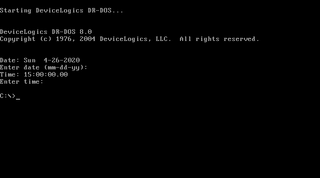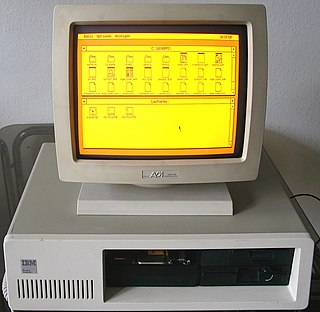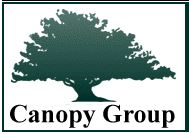History of DR-DOS

In 1994, Bryan W. Sparks, with help from Novell's Raymond John Noorda, founded Caldera, Inc. Caldera bought DR-DOS from Novell in 1996. [5]
| Industry | Computer software |
|---|---|
| Founded | November 2002 |
| Founder | Bryan Sparks, Bryce Burns, Troy Tribe |
| Headquarters | , |
| Products | DR-DOS |
| Website | www |
DeviceLogics was a company in Lindon, Utah, USA, founded in November 2002. Originally doing business mostly under the DeviceLogics name, the company was incorporated as DRDOS, Inc. for legal reasons. The DeviceLogics name was later dropped.
Bryan Wayne Sparks co-founded the company, together with Bryce Burns and Troy Tribe, and acquired DR-DOS from the Canopy Group, a Utah technology venture group. Copies of DR-DOS 7.03 have been licensed and distributed by this company. [1] [2] [3] [4] The company's web site went offline in 2018.

In 1994, Bryan W. Sparks, with help from Novell's Raymond John Noorda, founded Caldera, Inc. Caldera bought DR-DOS from Novell in 1996. [5]

DR-DOS is a disk operating system for IBM PC compatibles. Upon its introduction in 1988, it was the first DOS attempting to be compatible with IBM PC DOS and MS-DOS.

GEM is an operating environment which was created by Digital Research (DRI) since 1984 for use with the DOS operating system on Intel 8088 and Motorola 68000 microprocessors.

Digital Research, Inc. was a company created by Gary Kildall to market and develop his CP/M operating system and related 8-bit, 16-bit and 32-bit systems like MP/M, Concurrent DOS, FlexOS, Multiuser DOS, DOS Plus, DR DOS and GEM. It was the first large software company in the microcomputer world. Digital Research was originally based in Pacific Grove, California, later in Monterey, California.

Novell, Inc. was an American software and services company headquartered in Provo, Utah. Its most significant product was the multi-platform network operating system known as Novell NetWare. Under the leadership of chief executive Ray Noorda, NetWare became the dominant form of personal computer networking during the second half of the 1980s and first half of the 1990s. At its high point, NetWare had a 63 percent share of the market for network operating systems and by the early 1990s there were over half a million NetWare-based networks installed worldwide encompassing more than 50 million users. Novell technology contributed to the emergence of local area networks, which displaced the dominant mainframe computing model and changed computing worldwide. Novell became instrumental in making Utah Valley a focus for technology and software development.

FreeGEM released in 1999 is a windowing system based on Digital Research's GEM which was first released in 1985. GEM stands for "Graphics Environment Manager".

Caldera International, earlier Caldera Systems, was an American software company that existed from 1998 to 2002 and developed and sold Linux- and Unix-based operating system products.
Star Trek is the code name that was given to a secret prototype project, running a port of Macintosh System 7 and its applications on Intel-compatible x86 personal computers. The project, starting in February 1992, was conceived in collaboration between Apple Computer, who provided the majority of engineers, and Novell, who at the time was one of the leaders of cross-platform file-servers. The plan was that Novell would market the resulting OS as a challenge to Microsoft Windows, but the project was discontinued in 1993 and never released, although components were reused in other projects. The project was named after the Star Trek science fiction franchise with the slogan "To boldly go where no Mac has gone before".
Raymond John "Ray" Noorda was a U.S. computer businessman. He was CEO of Novell between 1982 and 1994. He also served as chairman of Novell until he was replaced in 1994.

The Canopy Group is an American investment and property management firm founded by Ray Noorda in 1995 through the Noorda Family Trust. It is headquartered in Lindon, Utah. At various times it has consisted of, or been known as, Canopy Technologies, Canopy Properties, and Canopy Ventures.

ViewMAX is a CUA-compliant file manager supplied with DR DOS versions 5.0 and 6.0. It is based on a cut-down runtime version of Digital Research's GEM/3 graphical user interface modified to run only a single statically built application, the ViewMAX desktop. Support for some unneeded functions has been removed whilst some new functions were added at the same time. Nevertheless, the systems remained close enough for ViewMAX to recognize GEM desktop accessories automatically and to allow some native GEM applications to be run inside the ViewMAX environment. Many display drivers for GEM 3.xx could be used by ViewMAX as well, enabling ViewMAX to be used with non-standard display adapters and higher resolutions than possible using the default set of ViewMAX drivers. Also, Digital Research's SID86, the symbolic instruction debugger that shipped with DR DOS 3.xx and provided dedicated functions to debug GEM applications, could be used for ViewMAX as well.

Multiuser DOS is a real-time multi-user multi-tasking operating system for IBM PC-compatible microcomputers.
Lineo was a thin client and embedded systems company spun out of Caldera Thin Clients by 20 July 1999.

Arachne is a stable Internet suite containing a graphical web browser, email client, and dialer. Originally, Arachne was developed by Michal Polák under his xChaos label, a name he later changed into Arachne Labs. It was written in C and compiled using Borland C++ 3.1. Arachne has since been released under the GPL as Arachne GPL.
Caldera OpenLinux (COL) is a defunct Linux distribution. Caldera originally introduced it in 1997 based on the German LST Power Linux distribution, and then taken over and further developed by Caldera Systems since 1998. A successor to the Caldera Network Desktop put together by Caldera since 1995, OpenLinux was an early "business-oriented distribution" and foreshadowed the direction of developments that came to most other distributions and the Linux community generally.

The AARD code was a segment of code in a beta release of Microsoft Windows 3.1 that would determine whether Windows was running on MS-DOS or PC DOS, rather than a competing workalike such as DR-DOS, and would result in a cryptic error message in the latter case. This XOR-encrypted, self-modifying, and deliberately obfuscated machine code used a variety of undocumented DOS structures and functions to perform its work. The code was present in the installer, in WIN.COM, and in several other executables in the operating system.
Fear, uncertainty, and doubt is a propaganda tactic used in sales, marketing, public relations, politics, polling and cults. FUD is generally a strategy to influence perception by disseminating negative and dubious or false information and a manifestation of the appeal to fear.
Caldera was a US-based software company founded in 1994 to develop Linux- and DOS-based operating system products.
DOS Protected Mode Services (DPMS) is a set of extended DOS memory management services to allow DPMS-enabled DOS drivers to load and execute in extended memory and protected mode.
In computing, a hardware code page (HWCP) refers to a code page supported natively by a hardware device such as a display adapter or printer. The glyphs to present the characters are stored in the alphanumeric character generator's resident read-only memory and are thus not user-changeable. They are available for use by the system without having to load any font definitions into the device first. Startup messages issued by a PC's System BIOS or displayed by an operating system before initializing its own code page switching logic and font management and before switching to graphics mode are displayed in a computer's default hardware code page.

DR-WebSpyder is a DOS web browser, mail client and operating system runtime environment that was developed by Caldera UK in 1997. It was based on the DR-DOS operating system and networking components from Novell as well as the Arachne web browser by Michal Polák of xChaos software. The system was designed to run on low-end desktop systems, but being able to boot and execute from disk as well as from ROM or network, it was also tailored for x86-based thin clients and embedded systems with or without disk drives. Using the web browser as its principal user interface, it could be also used for kiosk systems and set-top boxes. Named Embrowser, it has been ported to Linux in 1999 and was called Embedix Browser since 2000.